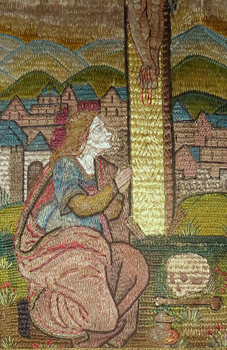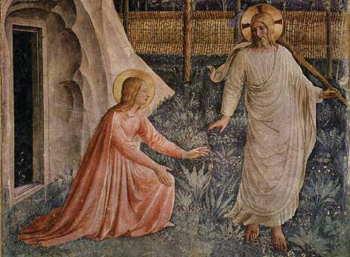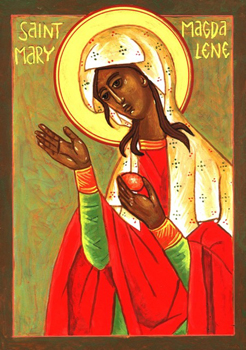For Sunday April 16, 2017
Easter Sunday
Lectionary Readings (Revised Common Lectionary, Year A)
Acts 10:34–43 or Jeremiah 31:1–6
Psalm 118:1–2, 14–24
Colossians 3:1–4 or Acts 10:34–43
John 20:1–18 or Matthew 28:1–10
A guest essay by Sara Miles. Sara Miles is the author of Take This Bread: A Radical Conversion; Jesus Freak: Feeding, Healing, Raising the Dead, and City of God: Faith in the Streets. For more about Sara, see www.saramiles.net
John 20: 1-18
Early on the first day of the week, while it was still dark, Mary Magdalene came to the tomb and saw that the stone had been removed from the tomb. So she ran and went to Simon Peter and the other disciple, the one whom Jesus loved, and said to them, “They have taken the Lord out of the tomb, and we do not know where they have laid him.” Then Peter and the other disciple set out and went toward the tomb. The two were running together, but the other disciple outran Peter and reached the tomb first. He bent down to look in and saw the linen wrappings lying there, but he did not go in. Then Simon Peter came, following him, and went into the tomb. He saw the linen wrappings lying there, and the cloth that had been on Jesus’ head, not lying with the linen wrappings but rolled up in a place by itself. Then the other disciple, who reached the tomb first, also went in, and he saw and believed; for as yet they did not understand the scripture, that he must rise from the dead. Then the disciples returned to their homes.
But Mary stood weeping outside the tomb. As she wept, she bent over to look into the tomb; and she saw two angels in white, sitting where the body of Jesus had been lying, one at the head and the other at the feet. They said to her, “Woman, why are you weeping?” She said to them, “They have taken away my Lord, and I do not know where they have laid him.” When she had said this, she turned around and saw Jesus standing there, but she did not know that it was Jesus. 1Jesus said to her, “Woman, why are you weeping? Whom are you looking for?” Supposing him to be the gardener, she said to him, “Sir, if you have carried him away, tell me where you have laid him, and I will take him away.” Jesus said to her, “Mary!” She turned and said to him in Hebrew, “Rabbouni!” (which means Teacher). Jesus said to her, “Do not hold on to me, because I have not yet ascended to the Father. But go to my brothers and say to them, ‘I am ascending to my Father and your Father, to my God and your God.’” Mary Magdalene went and announced to the disciples, “I have seen the Lord”; and she told them that he had said these things to her.
How to Be an Evangelist
Several years ago, in a town whose very name is synonymous with faithless, pot-smoking secularism, I found myself in a rather dumpy little Roman Catholic cinder block church one rainy afternoon, standing in line with swarms of noisy second-graders, Filipina grandmothers, big Mexican families, nerdy university students, and a bunch of Irish construction workers in windbreakers, all waiting, like me, to kiss a fragment of bone venerated for a thousand years and claimed to be from the tibia of Mary Magdalene.
 |
|
St-Joriskerk chasuble by Carolus.
|
Now, I’m not so much interested in whether this relic, or any relic, is “real,” or if it truly belongs to the same woman described in John’s Easter Gospel. Nor am I interested in proving scientifically whether all the stories about Mary Magdalene are accurate. No: what I’m interested in is ten centuries of kissing. And the power of evangelical witness to bring me to my knees in Berkeley, California. Because I’m very interested in what this Gospel has to teach us about how to become apostles and evangelists of Christ.
Mary Magdalene, hailed by the Eastern Church as “the apostle to the apostles,” is the first Christian evangelist. She was the first to witness the resurrected Jesus and share the good news with others — even though the men didn’t believe her — and she spoke with so much authority that on Easter morning, two thousand years later, we still hear the cry she launched for the first time: Christ is risen!
How did she become an evangelist and apostle? After Jesus cast out seven demons from Mary of Magdala — in contemporary language, healing her spiritual suffering and/or psychological distress and/or physical anguish — she became Jesus’ disciple, supporting him and the others from her own resources. Unusually for a woman of her time, Mary was in control of her own money, and made her own life decision to follow Jesus. Independent and unattached, she traveled freely with men and women she wasn’t related to, ministering to them without shame. In the Gospels, Mary Magdalene stands out because, remarkably, she’s not identified by a husband’s name, or a father’s, or as somebody’s sister or mother. She has her own name: the name Jesus calls her by.
Mary accompanied Jesus on his last journey to Jerusalem, and, with a group of other women followers, stayed close when the men had fled, to witness the crucifixion. She remained there faithfully, in that terrible place, until the body was taken down and laid in a tomb. After the Sabbath, in the early hours before dawn, the women went to anoint Jesus’ corpse, and found the tomb empty. Mary ran to tell other disciples, who went away when they found the body gone. But Mary remained at the door of the tomb, weeping. She saw two angels dressed in white and told them she didn’t know where her Lord had been taken. And when a stranger, just a gardener, addressed her, she begged him, too, to help her find Jesus’ body so that she could care for it. Mary was desperate to find out the truth about what had happened to her beloved friend and teacher.
And when the stranger said her name she knew the truth.
Mary, he said. Rabbouni, she said, embracing him. And then Jesus sent Mary out, as his ambassador, instructing: “Go to my brothers and say to them, ‘I am ascending to my Father and your Father, to my God and your God.'"
That’s the Word. That’s the Gospel.
And so let me share the three things I believe this story shows about how to become apostles, evangelists, like Mary Magdalene.
 |
|
Mary Magdalene and Jesus, Fra Angelico, ca. 1437–144.
|
First, all the Gospels suggest quite strongly that Jesus, and thus evangelical witness to Jesus, belongs to people who have little to lose when it comes to worldly status — like the lepers, loose women, cripples, drunkards, foreigners, prisoners, slaves, and helpless babies who populate Jesus’ parables, and his heart. People like Mary Magdalene, or the poor stumbling fisherman Peter, or Jesus’ own humiliated mother. People whose sickness or craziness or lack of correct religion makes them unclean, whose scandalous social position strips them of privilege. In the modern world, that would be people like me: a lesbian high-school dropout with part-time jobs and an illegitimate child.
Of course, dig a little deeper, and the Gospels also show that Jesus, and thus evangelical witness to Jesus, belongs to people who, in the eyes of the world, have a lot of power and privilege. People like a rich young man, a landowner, a woman of independent means, a patriarch and the wealthy, party-throwing kings who populate Jesus’ parables, and his heart. People like Mary of Bethany, or the tax collector Zaccheus, or the president of the synagogue. In the modern world, that would be people like me: a white woman with a United States passport and a home of my own.
Do you follow? Whether you have three houses or three minimum-wage jobs, being an evangelist isn’t about how other people see you. Jesus sees you, and he calls you by your own name. Jesus will send you out to do what needs to be done. You belong to Jesus. And the only trick about becoming his apostle is that you have to be willing to lose yourself. As did everyone, rich or poor, who left their nets behind, left the dead unburied, left a luxurious home or a dirt-floor hut, left family, familiarity, even the respect of other disciples, to follow Jesus and proclaim his Gospel.
So the first thing to know about becoming an apostle is that it’s a role open to everyone.
The second thing this Gospel teaches about becoming an apostle is that you need to look into the tomb for yourself. You need to go right up to the scariest, ugliest, saddest place in the world, before the sun has risen, and look without flinching into every dark corner. It’s easier not to look too closely at what’s dead or missing; it’s so tempting to just take a quick glimpse around and leave, and maybe later you can pretend everything’s OK. But honestly: how many of us are sure everything’s OK?
If I really look closely at our world, I’m going to see people who are as broken-hearted as the disciples after their teacher was killed. Who hurt and are hurt by others, who live with violence. Who are possessed by and suffering from at least seven demons. I bet if I peer in, I’ll find something a lot like the broken bodies of the thieves and petty hoodlums executed next to Jesus; I’ll find the casual cruelty of the police and soldiers and the terror of the complicit crowd. And I know if I look into my own soul I’ll see myself falling asleep in the garden, denying the truth out of fear, and failing to be present for the people I should love the most. But the story of Mary Magdalene shows us: don’t be afraid. Even when it makes you weep, go right up to the tomb, and look in.
Because the second thing about becoming an apostle is that it requires you to experience Christ crucified. You cannot be an evangelist for the resurrection unless you know the tomb.
And the third requirement for becoming like Mary Magdalene — well, it’s something none of the other disciples could bring themselves to do. You have to talk to the gardener. You have to trust some stranger who comes to you in the worst moment, when you’re alone and weeping over the murder of your friend. Say, like Mary, your community is terrified and splintering. You’re lost in your own sorrow and fear of death: if the powerful didn’t spare him, why will they spare you? You’re in despair over your own helplessness, your own inability to make God do what you want.
 |
|
Mary Magdalene.
|
And then you run across someone who doesn’t matter, who isn’t the person you hoped to see, who’s sort of dirty and doesn’t belong in the picture…and you talk to him anyway. Through your tears, you ask for his help. You let him call you by name. You open yourself up to a low-caste stranger: and so you come to know the Word of the living God. Before you can be an evangelist you must be evangelized — by the gardener. Or, as the other apostles were, by a mere woman.
And that’s the third thing Mary Magdalene shows us: becoming an apostle requires receiving good news from strangers. It means listening for the Word of resurrection in the most unlikely places.
Oh, wait. There’s actually a fourth thing. Maybe the hardest. You have to run and tell your friends the story. “Listen, I have seen the Lord!” They won’t necessarily want to hear it. But don’t be afraid.
Mary Magdalene went on to proclaim the good news of her living Lord everywhere, preaching the Word in palaces and villages throughout the pagan world, until around 72 AD she finally died in Gaul, where that little piece of bone I kissed is said to have been found. According to one story, Mary Magdalene once brought an egg, symbolizing new life, to the Roman emperor Tiberius and told him about Jesus. “A person can no more rise from the dead,” said the emperor, impatiently, “than that egg can turn red.” The egg turned red in Mary’s hand. “Christ is risen,” she said.
So let us witness with her. To be an evangelist, you don’t have to be the right kind of person. You don’t have to know the right answers. You just have to hear Mary Magdalene, the first apostle, who’s still telling the rest of us disciples not to be afraid. Who is calling us to look into the tomb, talk to the gardener, and run to share the good news of Easter, always: Christ is risen!
He is risen indeed.
Copyright 2017 Sara Miles.
Image credits: (1) Wikipedia.org; (2) Parabola.org; and (3) Sara Miles.





